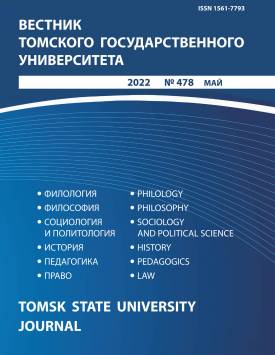The genesis of Eastern European text in Donna Tartt's novels: Bestiary and poetics of cold in The Secret History
This article deals with the problem of reception of Eastern Europe in Donna Tartt's novels as the first attempt to further studies. The material of the writer's first novel, The Secret History, highlights motifs related to the semantics of cold (winter, blizzard, pallor), oppositions of “North” and “South” (both in the plot of the novel and in the names of the characters), and bestiary symbols (associations with a dog, a rabbit, a bird, and deer hunting) in the plot, and onomastics of The Secret History. According to O.M. Freudenberg, the significance expressed in the character's name and, consequently, in their metaphorical essence unfolds into an action that constitutes a motif: the characters do only what they semantically mean. The influence of the Chronicles of Narnia by C.S. Lewis on the formation of the named complex of motifs (and the antique background of the story) is obvious; however, in the perspective of the following Donna Tartt's novels, these motifs are also included in the Eastern European text described by the American historian Larry Wolff in his work Inventing Eastern Europe (1994): with obligatory coldness (remoteness/detachment), savagery (animality), sensuality, ambivalence (up to inversions), theatricality, a mixture of attraction and frightening. The Secret History mentions two classics of Russian literature, Leo Tolstoy and Fyodor Dostoevsky, which allows us to note: the emerging “Eastern European” associations are not accidental. The motifs of cold and bestiary symbolism are also important in Tartt's second novel, The Little Friend (2002). However, in her third novel, The Goldfinch (2013), a secondary character Boris Pavlikovsky appears, connected by his fate with Russia, Poland, and Ukraine. This image will ultimately concentrate the considered motifs and symbols. However, the “East European” layer, of course, is only one of the significant semantic fields of The Secret History: associations with ancient mythology, the Elizabethan theater, and modern literary context (for example, the genre of a university novel) are also important. Nevertheless, in Tartt's first novel, methods and approaches are outlined, which manifested themselves more clearly in the following works - the more important it is to localize and track the development of motifs caused by an obvious interest in Eastern European culture and literature.
Keywords
Donna Tartt, Leo Tolstoy, poetics of cold, bestiary, Eastern EuropeAuthors
| Name | Organization | |
| Gevel Olga E. | Siberian Federal University | olyagevel@mail.ru |
References

The genesis of Eastern European text in Donna Tartt's novels: Bestiary and poetics of cold in The Secret History | Vestnik Tomskogo gosudarstvennogo universiteta – Tomsk State University Journal. 2022. № 478. DOI: 10.17223/15617793/478/2
